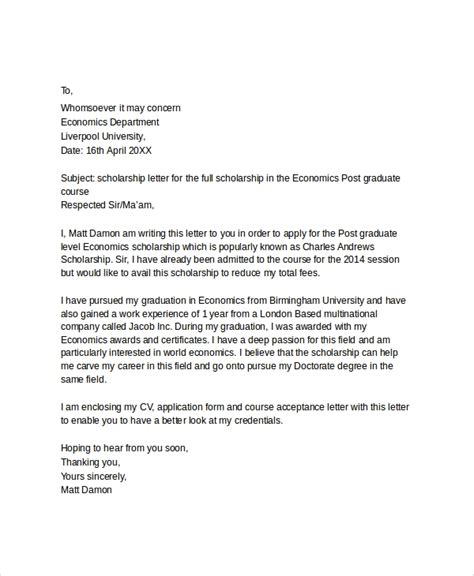Scholarship Application Letter: Guide And Template

Are you a student looking to secure a scholarship for your education? Writing a compelling scholarship application letter is a crucial step in the process. In this guide, we will provide you with a template and valuable tips to help you craft an impressive letter that stands out from the competition.
1. Understand the Requirements
Before you start writing your scholarship application letter, carefully read and understand the requirements set by the scholarship provider. Make note of any specific criteria, such as academic achievements, financial need, community involvement, or leadership qualities, that the scholarship committee is looking for.
2. Research the Scholarship Provider
Take the time to research the scholarship provider to gain a better understanding of their mission, values, and goals. This will allow you to tailor your letter to align with their objectives and demonstrate why you are an ideal candidate for their scholarship.
Example:
For instance, if you are applying for a scholarship offered by XYZ Foundation, mention their commitment to supporting students from underprivileged backgrounds. Highlight how their values resonate with your own aspirations and how receiving their scholarship would positively impact your education and future goals.
3. Personalize Your Letter
Avoid using a generic template for your scholarship application letter. Instead, personalize it by addressing the reader directly and mentioning specific aspects of the scholarship or organization that caught your attention. This shows your genuine interest and dedication to the opportunity.
Example:
Dear [Scholarship Committee Members/Specific Person’s Name],
I am writing to express my sincere interest in the [Name of Scholarship] offered by [Scholarship Provider]. The commitment of your organization to supporting students from diverse backgrounds deeply resonates with my own experiences and aspirations.
4. Highlight Your Achievements
Use your scholarship application letter as an opportunity to showcase your achievements, both academically and non-academically. Highlight any awards, honors, extracurricular activities, volunteer work, or leadership roles that demonstrate your dedication, skills, and potential.
Example:
During my high school years, I consistently maintained a top position in my class, earning a GPA of [X.X]. I have also actively participated in various community service projects, such as volunteering at [Organization Name] and leading a student-led initiative to raise funds for [Cause]. These experiences have not only shaped my character but also instilled in me a strong sense of responsibility and empathy towards others.
5. Explain Your Financial Need
If financial need is one of the criteria for the scholarship, provide a clear and concise explanation of your circumstances. Be honest and transparent, but also focus on how the scholarship will alleviate your financial burden and contribute to your academic success.
Example:
As the first person in my family to pursue higher education, I face significant financial challenges. My parents, who work long hours to provide for our family, struggle to meet the increasing costs of tuition, textbooks, and living expenses. Receiving the [Name of Scholarship] would not only relieve the financial burden on my family but also enable me to fully dedicate myself to my studies.
6. Showcase Your Goals and Aspirations
Articulate your long-term goals and aspirations in your scholarship application letter. Explain how receiving the scholarship will contribute to your academic and career growth, and how you plan to make a positive impact in your chosen field of study or community.
Example:
My passion for environmental conservation has driven me to pursue a degree in Environmental Science. With the assistance of the [Name of Scholarship], I will have the opportunity to gain a comprehensive education in this field and contribute to innovative solutions for pressing environmental issues. I am committed to dedicating my career to protecting our planet and advocating for sustainable practices.
7. Follow Proper Formatting and Proofread
Ensure that your scholarship application letter follows proper formatting guidelines, including a professional font, size, and spacing. Proofread your letter multiple times to eliminate any grammatical or spelling errors. A well-presented and error-free letter demonstrates your attention to detail and professionalism.
8. Seek Feedback and Revise
Before submitting your scholarship application letter, seek feedback from trusted individuals, such as teachers, mentors, or family members. They can provide valuable insights and suggestions to help you improve your letter. Revise and refine your letter based on their feedback.
9. Submit Application on Time
Ensure that you submit your scholarship application letter before the deadline. Late submissions may not be considered, regardless of the quality of your letter. Keep track of important dates and allow ample time to complete and review your application.
10. Follow Up
After submitting your scholarship application letter, consider following up with the scholarship provider to confirm receipt and express your gratitude for the opportunity. This demonstrates your enthusiasm and professionalism.
Conclusion
Writing a scholarship application letter requires careful thought and preparation. By understanding the requirements, personalizing your letter, highlighting your achievements, explaining your financial need, showcasing your goals, and following proper formatting, you can increase your chances of securing a scholarship. Remember to seek feedback, proofread diligently, and submit your application on time. Good luck!
Frequently Asked Questions
-
How long should a scholarship application letter be?
While there is no set length for a scholarship application letter, it is recommended to keep it concise and focused. Aim for one to two pages, highlighting the most important aspects of your achievements, goals, and aspirations.
-
Can I use the same scholarship application letter for multiple scholarships?
It is not advisable to use the same letter for multiple scholarships. Each scholarship has its own specific requirements and criteria. Tailoring your letter to each scholarship provider shows your dedication and increases your chances of success.
-
Should I include my GPA in the scholarship application letter?
If your GPA is strong and meets the requirements of the scholarship, it is recommended to include it in your letter. However, if your GPA is not as competitive, focus on highlighting other achievements, strengths, and qualities that make you a deserving candidate.
-
Is it necessary to explain my financial need in the scholarship application letter?
If financial need is one of the criteria for the scholarship, it is important to explain your circumstances. However, if the scholarship does not specifically mention financial need, you may choose to focus more on your achievements, goals, and aspirations.
-
Should I send additional documents along with the scholarship application letter?
Follow the instructions provided by the scholarship provider. Some scholarships may require additional documents, such as academic transcripts, recommendation letters, or a personal statement. Ensure that you submit all the required documents along with your letter.
